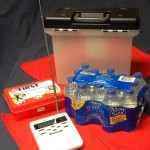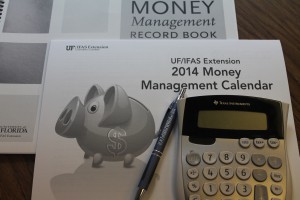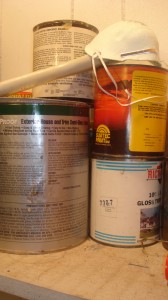by Elizabeth | May 28, 2014
 May 25 – 31, 2014 is National Hurricane Preparedness Week.
May 25 – 31, 2014 is National Hurricane Preparedness Week.
This week is a good time to prepare your family, property, and pets for severe weather situations. The dangers of a hurricane are numerous: heavy rainfall, flooding, high winds, tornadoes, and in our coastal areas, high tide and rip currents. UF/IFAS Extension has information to help you prepare for the season.
1. Create a plan for your family. Where can your family go in case of an evacuation? Do you plan to stay put and hunker down until the storm passes? Is your house “secure” enough to sustain high winds?
2. Organize your important papers. When it comes to preparing for weather emergencies, knowing where your important documents are is as important as having a plan for your family. Having all your documents up-to-date, accessible, and portable can make a big difference at a tense time.
3. Check your insurance. Will any of the policies you hold pay for temporary shelter, replacement clothing, furniture, or other items if you are affected by a hurricane? Are floods covered in the policy? What is the amount of your hurricane deductible? Visit the Federal Emergency Management Agency (FEMA) or the Florida Disaster Recovery website for more information. Find out whether you can flood-proof your home now.
4. Plan for your pets. Include the welfare of your pets in your plan. Many public shelters do not allow pets so make arrangements to board your animals. Keep ID tags and vaccinations up to date. Prepare a pet evacuation kit, including food and water for one week, a manual can opener, medications, medical/vaccination records, a pet carrier, and bedding. Planning can help ensure safety for you and your pets during a weather emergency.
Bookmarks for more information:
If a hurricane affects you this year, return to this website for tips on recovery and information about your rights.
by Elizabeth | Mar 31, 2014
 As you are clearing out clutter, sprucing up, and getting ready for summer, you also should start your financial spring cleaning by figuring out where you stand financially. Here are a few tips to help you get started:
As you are clearing out clutter, sprucing up, and getting ready for summer, you also should start your financial spring cleaning by figuring out where you stand financially. Here are a few tips to help you get started:
1. Get organized.
Build a personal financial filing system; get out your financial paperwork and file it in order of importance. Separate bills – that way, you can track them as they come in, reducing the chance of missed or late payments.
Use a plastic tote for a filing cabinet – these keep your files dry and are easy to carry from one room to the next should you need to.
2. Create a budget.
How much money do you have? Are you spending more than you earn? If you don’t have a spending record, start one. You can still get on with your financial spring cleaning today. If you haven’t been keeping a record, just make a deliberate effort to start now. Try to note all your spending for the next month, right down to the candy bar. Then, in a month’s time, you’ll be able to see where your money is going and, hopefully, see some areas where you can cut back.
3. Pay off Debt
Now, let’s discuss what most people agonize over, but is a very important subject: debt. If you have any debt beyond a mortgage, you should try to focus on paying off this debt as quickly as possible. It’s also important to try to negotiate your interest rates down with your credit card company if you can. Although this option may not be available to everyone, especially if your credit is not good, it’s worth trying.
If you are not successful, you can use these steps to reduce debt:
- Stop using credit; charging new items increases the balances on what you already owe.
- Do not open new lines of credit.
- Request a free copy of your credit report from www.annualcreditreport.com and honestly assess the problem. Understanding your situation helps when trying to resolve debt issues. Stop denying that you have a debt problem and work on it. You can analyze your debts using Powerpay®. This website gives you a personalized report and plan to reduce your debt based on your input.
- Break your debt load into manageable chunks; define your goal and focus on reducing manageable amounts.
For more information on financial education and tools to help you get out of debt; contact your local county Family & Consumer Sciences Agent.
by Elizabeth | Sep 30, 2013
So now the weather is cooling off and you’ve been thinking about doing something to give your home a much-needed facelift. Perhaps now you’re thinking you want to add some seasonal touches. The easiest way to spruce up a home is with a coat of paint. Painting will give the home an updated, refreshed look and the home will immediately seem more defined and welcoming.

Spruce up your house with a fresh coat of paint.
The best time to paint the interior of a home is in the fall or spring. The cooler weather makes working both inside and out much more pleasant. Cooler weather also allows you to ventilate the rooms by opening up windows. When it comes to the job itself with so many paint choices, which one should you choose? Lead-based paints seem to have been eliminated from the US market, however, there are still other issues with paint that need addressing.
According to the Green Builders Coalition, all paint comes in three parts: pigment that gives it color; the binder, or resin, that makes the pigment stick when the paint is applied and forms a solid layer of paint; and the carrier, or solvent, that keeps the paint in liquid form and evaporates once the paint is exposed to air. All of these contain different chemicals. Other substances or chemicals may be added to paint to give it special characteristics, such as mold resistance or moisture resistance.
One additive besides lead that has received much attention recently is volatile organic compounds, or VOCs. Why are VOCs in paint in the first place? They are the “glue” that keeps the pigment and the binder or resin in a liquid solution long enough for the paint to be applied, then they conveniently evaporate so the paint can dry. Therefore, VOCs do serve a necessary function in paint.
Why is there a major concern over high-VOC paints? Like anything that produces high vapors, paints that have high-VOCs may cause or trigger respiratory problems. Consumers need to be aware that, although evaporation is greatest during and right after application, it may continue at lower levels for months. The emitted gases mix with the air in the room, exposing occupants to chemicals that can cause short- and long-term respiratory problems.
The solution is not to leave the house unpainted, but to find low- or no-VOC paints, which are now sold side-by-side with conventional high-VOC paints. Most home improvement stores carry these; consumers just have to do their homework. While there are no building code limitations on use of low-VOC paints, it is imperative that consumers find out more about the product before they select it. The EPA website, http://www.epa.gov/iaq/voc.html#Health_Effects, offers more information on VOCs in general. The National Association of Home Builders also has posted a guide consumers can use to select low-VOC paint on their website: http://www.toolbase.org/Technology-Inventory/Interior-Partitions-Ceilings/low-voc-paints.
Sprucing up your home can be very exciting and painting your home is a great way to express your individuality and ensure your home reflects your sense of style and personality. For more information on maintaining your home, visit the University of Florida/IFAS Extension publications website at http://edis.ifas.ufl.edu/topic_homes.
by Elizabeth | Mar 7, 2013
SHOPPING FOR A CARD
Here are some tips on choosing the best card for you:
- Will the card be accepted in places where you want to use it?

- Is there a minimum requirement for the card to remain usable?
- Are there reload limits?
- Is there a daily cash withdrawal limit?
- Are there convenient ATMs where you can make withdrawals?
- Are there fees charged for withdrawals or other activity?
MANAGING YOUR CARD:
Like any account you have, reloadable cards require that you monitor your account. This will prevent you from being charged for unnecessary services.
Monitor your balance to prevent over the limit usage.
FEES:
Not all cards are created equal just like credit cards. One needs to read the small print on the cards website before “loading “it. Below are the most common charges associated with prepaid cards:
- Purchase fees: A charge for buying the card normally at a retail store.
- Activation fees: One time charge also known as opening fee. This fee can be from $30 or more.
- Monthly maintenance fee: A common fee that can vary depending on the card. This fee can be upwards of $10 a month.
- Reloading fee: Fees applied when one adds more money to the card. These may also include third party fees.
- Purchase transaction fee: May be waived for some direct deposit cards.
- Overdraft fees: Just like debit and credit cards some cards will charge if one spends more than what is on the card.
- Cashier withdrawal: Charged when one withdraws at a bank or an agent location
- ATM fee: Charged for withdrawing money from an ATM machine. Some cards do have free withdrawals at participating ATM locations.
- Denied Transaction Fee: Some cards charge if your purchases are denied because there is no money on the card.
- Funds transfer fees: May be charged for transfers made from one card to the other.
- Balance Inquiry fee: Charged for getting your balance statement.
- Inactivity fee: If you don’t use the card (typically in 60 to 90 days) you will get charged.
- Card Replacement fee: Charged if your card is lost or stolen.
- Customer service fee: Charged by some card issuers when you contact their customer service department.
- Foreign Currency conversion fee: If you use the card outside the U.S., you may be charged. Credit and debit card issuers may do this as well.
For more information on pre-paid cards and the rules that govern them visit these federal agencies websites below or the University of Florida Family Youth and Community Sciences at http://fycs.ifas.ufl.edu/
*Federal Deposit Insurance Corporation (FDIC) www.fdic.gov
*Federal Trade commission (FTC) www.ftc.gov
*Federal Reserve Bank www.federalreserve.gov
*Consumer Financial Protection Bureau (CFPB) www.consumerfinance.gov
by Elizabeth | Mar 4, 2013
What are prepaid cards?
Pre-paid cards or network branded prepaid cards are not credit cards, although they are sometimes marketed as “prepaid credit cards”. No credit is offered by the card issuer and the cardholder spends money which has been prepaid to a card. The value is not physically stored on the card. Instead, the card number uniquely identifies a record in a central database, where the balance is recorded. In many ways, a reloadable card is similar to a credit or debit card. Like most debit and credit cards, many reloadable cards carry a logo from one of the major electronic payment networks; Visa, American Express, Discover or MasterCard. Any business that accepts these logos around the world are likely to accept the reloadable card.
Prepaid cards have been marketed to consumers with poor credit who are unable to qualify for the line of credit that backs a mainstream credit card. The fees associated with these cards are often very high. Though convenient, these cards can be an expensive way to spend your own money.
A major difference between prepaid cards and a credit or a debit card is that the cards have to be “loaded” before one can use them. In other words one must put money on the card before one can use it. When the balance gets low, one can reload (add more money) as the name implies. Depending on the card, one can reload online, in person, and/or through a direct deposit from a work place.
Prepaid cards advantages:
- The cards can be safer than cash. If the card is registered with an issuer and it’s lost, one can recover their full balance.
- They are convenient like credit cards but don’t allow users to carry a balance.
- Account activity does not impact one’s credit.
- Credit checks are not required to get a prepaid card.
- Prepaid cards that allow direct deposit may save one some money by allowing online and telephone payments for other debts just like a credit or debit card.
- The money on the card is protected by the FDIC insurance or by laws requiring consumers to have access to those funds.
- A prepaid card “may” teach young people how to use credit cards responsibly and how to stick to a budget.
- Prepaid cards can be used internationally.
Disadvantages:
- Prepaid cards are loaded with fees that make them more expensive to have and to use.
- Prepaid cards cannot help one establish or build a good credit history
For more information on this and other types and uses of credit cards visit the Federal Reserve “What You Need to Know Series” at http://federalreserve.gov/consumerinfo/wyntk.htm or the University of Florida Family Youth and Community Sciences at http://fycs.ifas.ufl.edu/
 May 25 – 31, 2014 is National Hurricane Preparedness Week.
May 25 – 31, 2014 is National Hurricane Preparedness Week.


